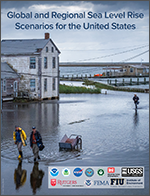Approximately one-fourth of all National Park Service (NPS) sites are situated on or near the coast. These parks protect a diverse array of ecosystems and habitats, historic and cultural sites, recreational areas, and facilities and infrastructure. From the submerged reefs of Biscayne National Park to the elevated span of the Golden Gate Bridge, coastal parks are experiencing effects from sea level rise. Sea level rise increases coastal erosion and flooding and the NPS seeks to respond to these impacts in ways that avoid or mitigate impacts to park resources and safe visitor access. Parks need the best available sea level rise and storm surge projections to inform management, planning, and decision making. Explore this ArcGIS StoryMap to learn more about sea level change in national parks.

Explore sea level rise scenarios
The U.S. Sea Level Change website and the Interagency Task Force on Sea Level Change are coordinated efforts across Federal Agencies to provide current data, information and resources related to sea level change. The NPS recognizes these efforts as leading sources of information for guiding park planning and decision making, including as part of scenario planning for climate adaptation.The 2022 Global and Regional Sea Level Rise Scenarios for the United States report [PDF] and associated datasets serve as the foundation of our current best available sea level rise projections. This report provides sea level rise projections by decade (through 2150) and scenario (high, intermediate high, intermediate, intermediate low) to provide a range of potential conditions. While all scenarios should be considered, the NPS typically recommends informing decisions with the intermediate high and high scenarios.
- Visit the U.S. Sea Level Change homepage
- Learn about sea level 101
- View past, present, and future sea level rise impacts for U.S. coastlines using the National Sea Level Explorer
View interactive sea level rise projections
The National Oceanic and Atmospheric Administration (NOAA) provides an interactive sea level rise viewer based off the 2022 dataset. The viewer illustrates projected flooding associated with projected sea level rise scenarios through 2100 in 1ft increments for up to 10ft of sea level rise. The viewer also allows the user to select "local scenarios" to explore site-specific conditions. Data related to water depth, connectivity, flood frequency, high tide flooding, wetland loss and migration, socio-economic vulnerability, and mapping confidence is also available in this tool.
Please note the NPS Sea Level Rise and Storm Surge Projections report published in 2017 no longer provides the most up-to-date information. The report is provided here for archival purposes only.
More about sea level change from around the NPS
Last updated: February 13, 2025

